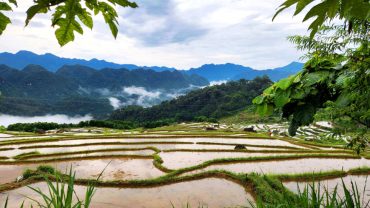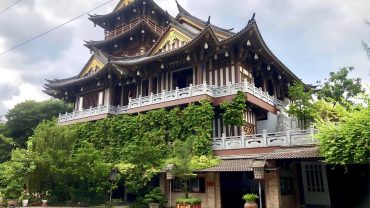Ha Giang’s cuisine, including dishes like five-color sticky rice, buckwheat cakes, leaf-fermented corn wine, grilled stone moss, hunchback chung cake, sausages, and Thang Co, reflects the rich culinary heritage of the region’s 19 ethnic groups. These traditional dishes are crafted using unique natural ingredients from the northern mountains, such as mac khen, doi seeds, star anise, cardamom, and honey, showcasing the distinctive flavors of each ethnic group.
## Thang Co
Thang Co, which translates to “meat soup,” is a traditional and iconic dish of the Mong people, originally made with horse meat, offering a flavor profile that is truly unique to their culture. The dish holds a special place in Mong culinary heritage, as it has been passed down through generations. However, to cater to modern tastes and the preferences of tourists, many restaurants now substitute the original horse meat with other types of meat such as buffalo, beef, and pork while still preserving the traditional essence of the dish.
The heart of Thang Co lies in its rich and flavorful broth. This broth is made by simmering bones and various organs, which imparts a deep, umami flavor to the dish. What sets the broth apart is the combination of 12 distinctive spices, including star anise, cardamom, and lemon leaves, which are meticulously blended to create a harmonious and aromatic base. These spices give the broth its signature fragrance and elevate the complexity of flavors.
[image-1|thang-co-ha-giang|Steaming bowl of Thang Co|A close-up shot of a steaming bowl of Thang Co, showcasing the rich broth, tender meat, and garnishes. The broth should have a deep color, and the meat should look succulent. The image should also highlight the accompanying ingredients like Men Men and grilled corn cakes, capturing the rustic charm of this traditional Mong dish.]
The meat is first lightly stir-fried to seal in the flavors, then added to the simmering broth, where it cooks slowly over low heat until it becomes tender and succulent. The slow cooking process allows the meat to fully absorb the fragrant spices and the richness of the broth, resulting in a hearty and deeply satisfying dish.
Thang Co is traditionally served alongside Men Men, a dish made from finely ground steamed cornmeal, which adds a slightly sweet and earthy contrast to the savory soup. Grilled corn cakes, with their smoky and crisp texture, are another common accompaniment, along with corn wine, a potent local beverage that complements the meal perfectly. The combination of Thang Co, Men Men, grilled corn cakes, and corn wine makes for a rustic yet flavorful dining experience that offers a true taste of the Mong people’s culinary traditions.
## Five-colour sticky rice
This vibrant dish is a culinary hallmark among nearly all ethnic minority communities in the mountainous regions of Northern Vietnam. Known for its striking visual appeal, the dish is characterized by its five distinct colors, each symbolizing a core element of Vietnamese spiritual beliefs. What makes this dish truly unique is the natural process used to create its brilliant hues. Rather than relying on artificial coloring or chemicals, the rich colors are derived entirely from various natural leaves and plants, a tradition that has been passed down through generations.
[image-2|five-color-sticky-rice-platter|A platter of vibrant five-color sticky rice|A top-down shot of a platter showcasing the five-color sticky rice in all its glory. Each section of rice should have a distinct, vibrant color, arranged beautifully on the platter. The image should capture the visual appeal of this traditional dish, emphasizing the natural ingredients used to create the colors.]
The five colors of the dish—yellow, green, red, white, and black—each hold deep cultural significance in Vietnamese belief systems, representing the five elements of life: yellow symbolizes earth, green signifies plants, red represents fire, white stands for metal, and black embodies water. These elements are not only seen as integral to the natural world but are also believed to be essential for maintaining the harmony and balance between heaven, earth, and humanity.
The careful preparation of this dish goes beyond mere aesthetics. Each color is infused into the rice through an intricate process. For example, black is often achieved by soaking the rice in water mixed with certain types of forest leaves, while red may come from leaves or fruits like gac, known for its fiery hue. Each of these colors and their corresponding elements is thought to bring specific blessings and good fortune to those who enjoy the meal.
## Au Tau porridge
The bowl of porridge carries a rich, fatty flavor combined with a slight bitterness from au tau, balanced with the delicious aroma of fresh chicken eggs and fragrant herbs. Au tau, a distinctive tuber from Ha Giang, is highly valued in this region. The Mong people have a traditional method of preparing au tau by soaking it in rice water to reduce its bitterness and toxicity. Afterward, the tuber is slow-cooked for about 4-5 hours until it softens. Once tender, the au tau is pureed and cooked together with bone broth and a blend of yellow flower sticky rice and regular sticky rice to create a velvety texture.
[image-3|au-tau-porridge-ha-giang|A comforting bowl of Au Tau porridge| A close-up shot of a steaming bowl of Au Tau porridge, highlighting its creamy texture and appetizing toppings. The porridge should have a light, earthy color, and the toppings like minced pork and scallions should be clearly visible. The image should convey the warmth and nourishment of this traditional dish.]
When the porridge is ready, it is ladled into bowls and topped with minced lean pork, a sprinkle of salt, pepper, and fresh scallions. The combination of these ingredients gives the dish a hearty and comforting taste. Au tau porridge is not only flavorful but also highly nutritious, known to help with curing colds, relieving body aches, and promoting overall health.
In the cold winter months, especially amidst the rugged terrain of Ha Giang’s rocky mountains, enjoying a steaming hot bowl of this nourishing porridge becomes a heartwarming and unforgettable experience. Its warmth and richness provide comfort against the biting cold, making it a cherished dish for both locals and visitors alike.
## Buckwheat cake
The tiny seeds were crushed into fine powder and then mixed with water, poured into a soft mould rolled into bread, simple but special. The taste will not be confused with any other cake.
Visitors to Ha Giang to experience buckwheat flower paradise should not miss the opportunity to enjoy specialties made from buckwheat seeds that are delicious, unique, and popular such as: All kinds of cakes, pho, beer, noodles, dry rice vermicelli, wine. Buckwheat is a flowering herb with many colours of white, pink, purple, and red, and has long been famous as one of the symbolic flowers of Ha Giang.
## Hunchback chung cake
Hunchback chung cake is known as a famous dish of the Red Dao people in particular and the Ha Giang region in general. The cake contains upland sticky rice, small green beans, black pork raised mainly by local people, and galangal leaves to wrap. Hunchback chung cake is boiled for about 8-10 hours. Local people boil cakes using traditional wood stoves.
[image-4|hunchback-chung-cake-preparation|Preparing Hunchback Chung cake in Ha Giang| A wide shot of the preparation process of Hunchback Chung cake, ideally in a traditional setting. The image could show the ingredients being assembled, the cakes being wrapped in leaves, or the cakes being boiled in a large pot over a wood fire. The image should capture the cultural significance and the effort involved in making this traditional dish.]
On the journey to explore the karst plateau, visitors can also enjoy other wonderful dishes such as: Dong Van steamed rice rolls, Dong Van egg steamed rice rolls, Bac Me bamboo-tube rice, dried buffalo meat, sour pho, corn pho, thang den (stuffed sticky rice balls)…
## Some interesting things in Vietnam:




Comment (0)